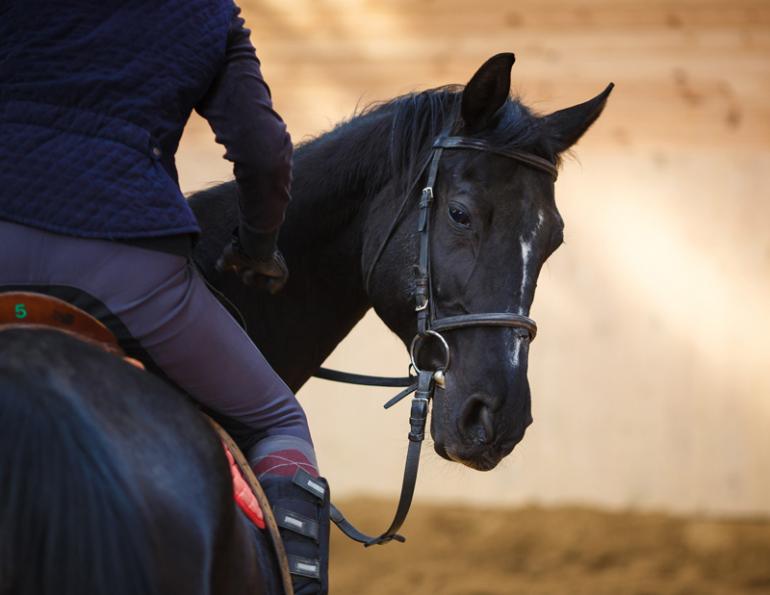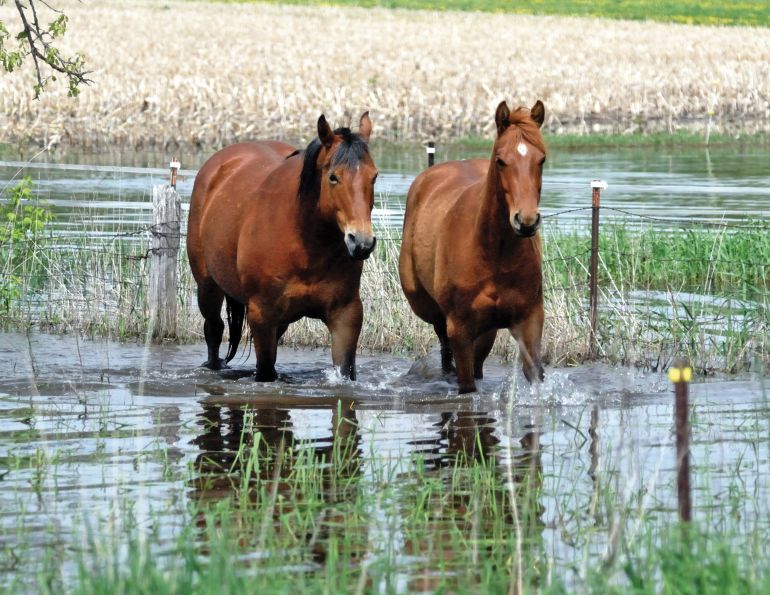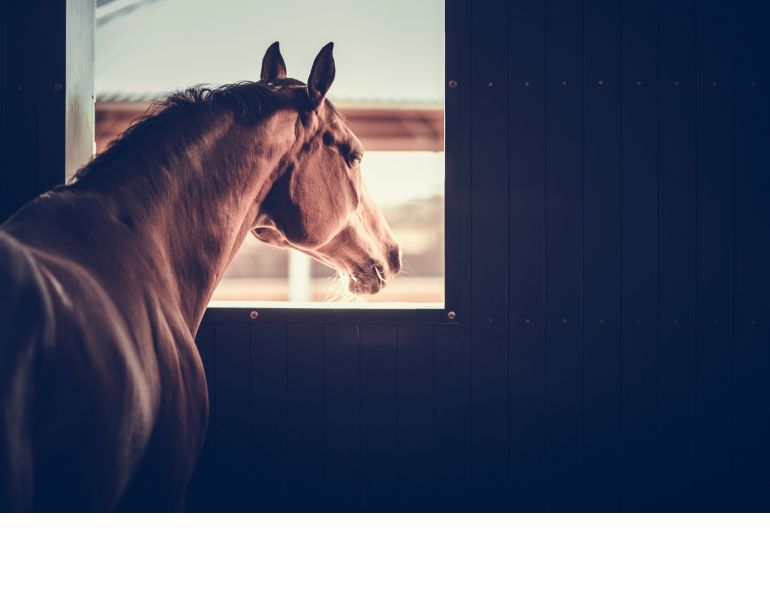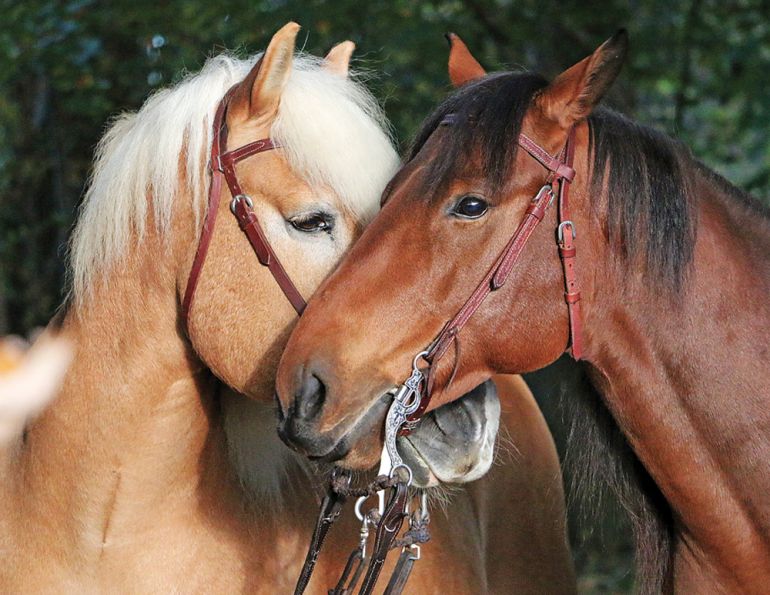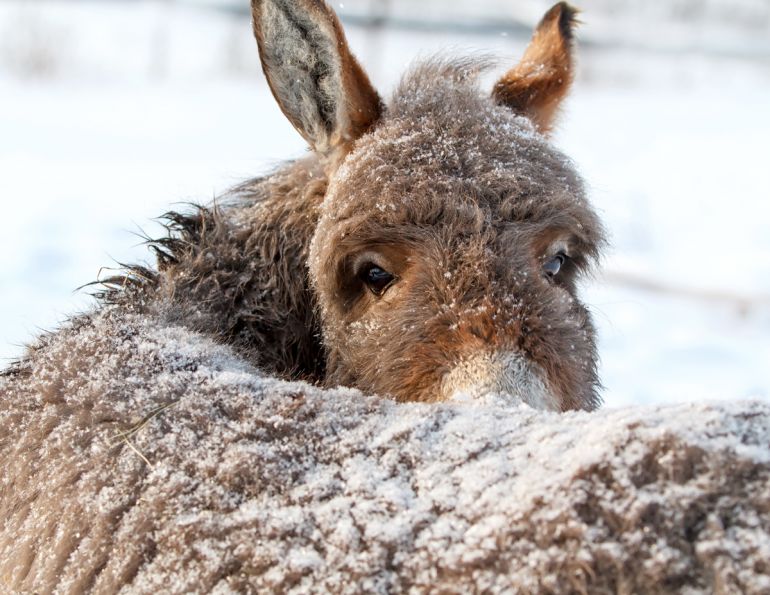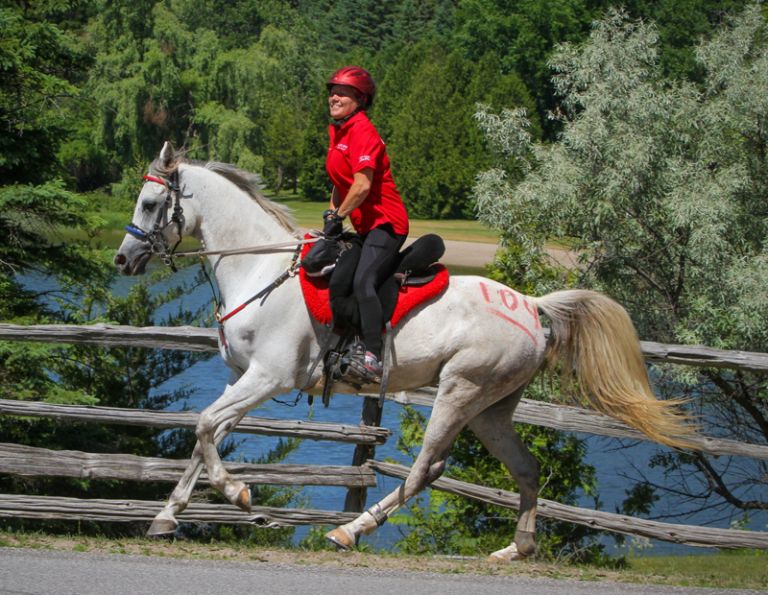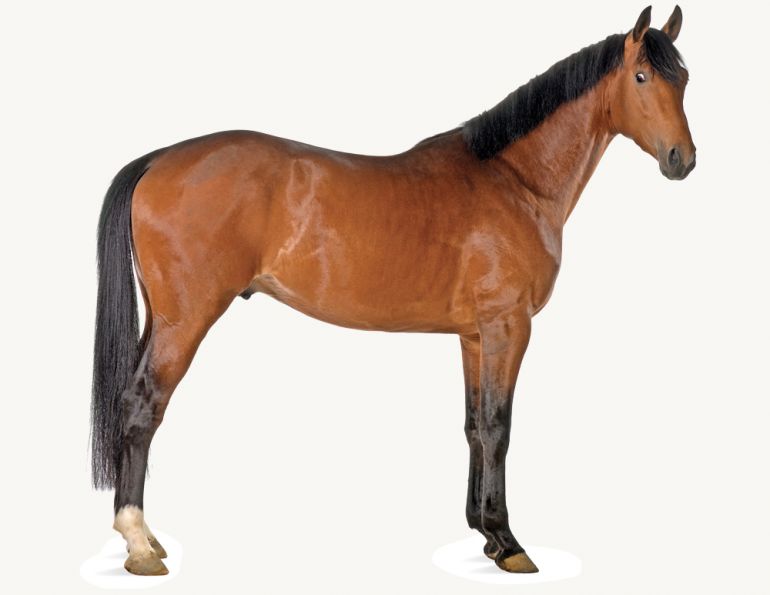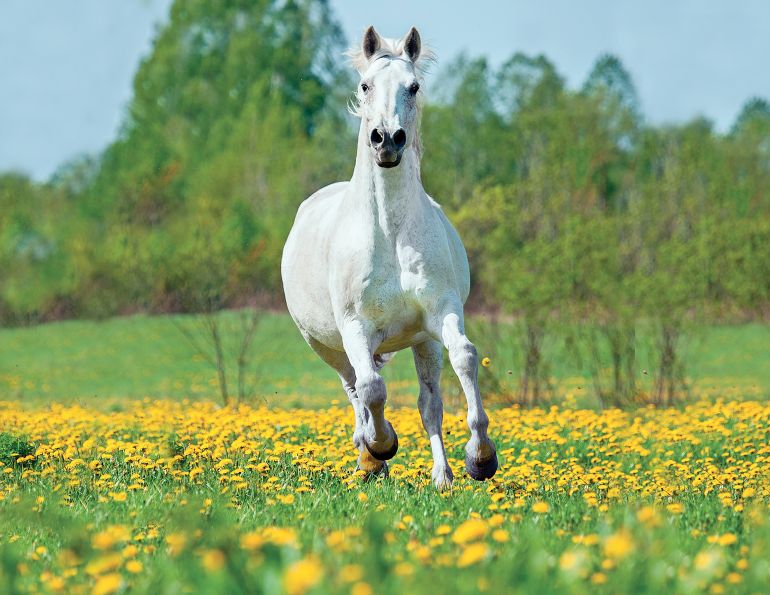By Margaret Evans
Horses are among the most free-ranging of domestic animals. They evolved as nomadic and migratory animals and have adapted to many variables in terrain and weather. They are built and instinctively driven to move, and their first reaction to anything remotely considered a threat is to flee. Domestication has changed some of these genetic qualities to fit human goals, but not by much.
Horses can tolerate heat and cold much better than humans, and some breeds have better tolerance than others. But what all of them seek to avoid is extremes of wind, rain, and snow as well as very hot temperatures and accompanying flies.
Blankets can address some of these issues but they have to be constantly changed and managed to keep the horse dry, and to adjust for major weather changes. The horse’s skin and coat together form a sensitive organ finely tuned to the vagaries and nuances of weather and atmosphere. The more naturally horses can be maintained, the better.
Horses kept outside in a secure paddock with a shelter or run-in shed can have a more natural lifestyle. They move in and out of their shelter at will, which benefits their digestion and allows their joints to flex naturally and effectively rather than moving in circles in a stall where they constantly put stress on hocks and hindquarters. They can choose to shelter from wind, rain and snow depending on the season. A major advantage of a run-in shed is the sheer simplicity and economy of horse accommodation.
Building or installing a run-in shed is relatively easy but, before you begin, some planning is needed. To decide exactly what you need, start by considering the nature of the horses you have. If it’s just one horse, a simple three-sided shed of ample height and depth and a good drainage base is fine. But if you have several horses, consider their temperaments and the nature of the herd leader.
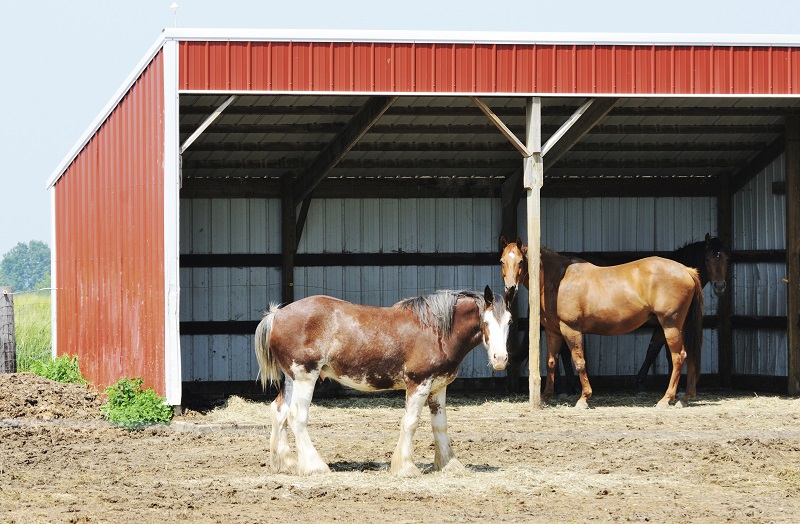
Run-in sheds offer a more natural form of shelter than a traditional stall by giving horses the freedom to move in and out as they please. They also offer better ventilation and are safe provided they are well maintained. Photo: iStockphoto/Steve Everts
Size
A shed needs to be expansive enough to safely accommodate the horses so that each can still have a sense of personal space. Geldings may get along pretty well in their buddy pack, but add a mare to the mix and she might be intolerant of other horses in her shelter space. Plan the shelter with escape access in mind. You don’t want a panicky horse trapped in the back of the shed by a dominant animal that won’t let him pass, putting horses at risk of injury and the structure at risk of damage.
With two horses you need more than double the space for one. But a yardstick should be at least 100 square feet per horse, or use a 12x12-foot stall size as a general guideline for one horse. More space will be needed for larger animals such as warmbloods or draft horses. Remember, though, that not all the horses use the space at the same time except, of course, during severe weather.
Height should be at least eight feet at the lower (back) end and ten to twelve feet at the front, accounting for any jostling or rearing inside.
Location
Consider where to put the shelter and the direction its open side will face. Figuring out the best orientation can be tricky because weather can be so variable. What are your prevailing winds? From what direction do your winter storms come? How does sunlight track across the paddock during the day? It is important to place the shelter on high, dry ground so its back wall faces the prevailing winds while its open area doesn’t receive direct sunlight. It should be easily accessible to vehicles, yet away from gates so that you are not hindered when getting equipment in and out of the paddock for cleaning.
Related: Safe and Functional Horse Fencing
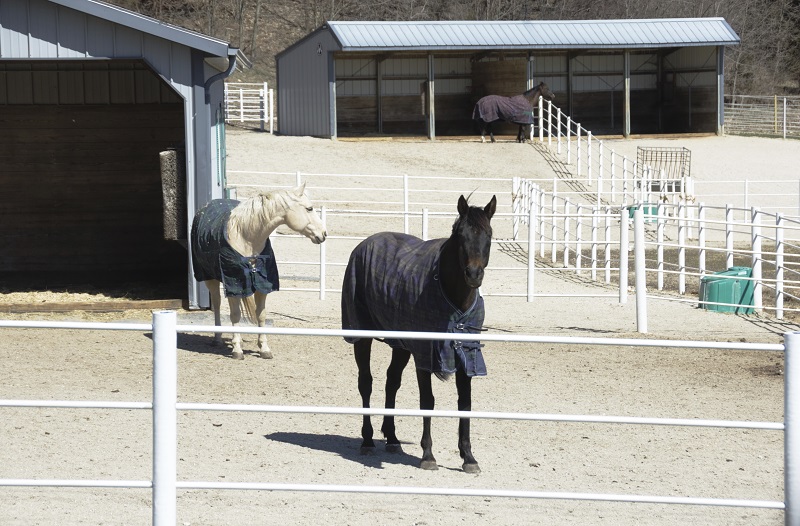
Locate your run-in shed where it is both convenient and will provide the best protection to your horses. Run-in sheds can be built in a variety of styles. When deciding on the size and type of construction to use, consider how many horses you have and their size, age, and temperaments, the climate of the area you live in, and personal aesthetics. Photo: Thinkstock/Steve Everts
If you have more than one pasture, consider placing the shed along the fence line so that, with built-in swing gate options in your design, your horses can run out to either one field or another as you manage the grazing for pasture rotation. In winter you could leave the swing gate open so they can access both pastures.
If the location is good but the footing less so, shore up the footing with deep, well drained fill topped with fine gravel and perhaps stone dust. Then cover that base with bedding of your choice such as wood shavings. The area will receive a lot of traffic so it must stand up. Expect to do some seasonal maintenance on the footing to keep it firm and well drained. Be prepared to muck out the shed regularly to remove manure and reduce flies.
If the location is not perfect, but the structure is deep and spacious, horses will still be able to get out of the wind, rain, heat, and flies.
Design
The sky’s the limit for shed design and there are some excellent designs for purchase available online, including complete shed kits down to the last nail. Some sheds can be constructed so they are mobile but will be more expensive than your own do-it-yourself project.
Sheds can be anything from three sides and a sloping roof to a run-in shelter with opened, partitioned stalls, a closed-in storage room for feed, a hay loft, and a tack room. Or sheds can be designed as multiple sheds in a row so that each horse can have free choice entrance to its own exclusive space. You can also build the roof with a front overhang to increase the shelter area.
If a storage room for tack is included, consider concreting this part of the shed to keep out moisture and rodents. Also consider insulating the walls of the storage room to contain warmth, which will be a lot easier on leather. The storage room can be used for halters, shanks, grooming tools, rugs, bandages, and medications which should be kept in a sealed container. Although this structure is still a run-in shed, you want it to be as multi-use and efficient for your own needs as possible.
Depending on the size of the shelter, the open end can have a swing gate to contain the horse. There are times when restricting the horse safely will be invaluable. You may want to use the shelter to tack up for a ride, as a place where your vet can administer shots or a health check, or where the farrier can do a trim. Plus, if you are using machinery to do a manure clean-up in the paddock, you will want the horses out of the way while you work and may need to open or close the main gate to pasture access.
Remember to include eavestroughs in your design so that rain or melting snow does not drip off the entrance roof and pool right in front. The downpipe can either drain into the underground or you can set it so that it drains into the horse’s water trough located to the side of the building, a good way to catch (and not waste) water.
Related: 50 Ideas for Improving Your Horse Property

Consider the hierarchy of your horse herd and the number of animals that will use the shed. Each horse should have some personal space. You may need a second shed if you have a really dominant horse that will prevent others from using the shelter. Photo: iStockphoto/Nancy Kennedy
Power
Consider putting power in the shed. Having light in the shelter will be enormously valuable in winter when you are feeding hay, checking over the horses, or changing rugs after work. If you have a veterinary emergency at night, having some sort of light source is essential. Consult with an electrical contractor on how to run some underground cable from the source to the shed. Consider having power outlets installed in a safe place where horses cannot access them. Consider the GFCI (ground-fault circuit interrupter) that is an electrical outlet that can stop power within milliseconds for safety.
Water Supply
If possible, consider a water supply to the shed to not only fill the water trough but provide water for hosing, washing, and cleaning. Your local plumber will need to be consulted on trenching a line from your main supply to the shed and safely bringing water into the shelter. Discuss with him the water supply and maintenance from the perspective of your worst winter freezing conditions.
Materials
If you decide to build your own shed, before starting be sure to check with your local municipality for any necessary building permits. You must be following building codes to standard. But you need to know what restrictions there are such as where you can build so that you can conform to regulations. They will most likely want to see your building plans.
Once the site is decided upon and the footing prepared, construction materials will include treated 6x6 treated support posts set in the ground to below the depth of the frost line. For the framing, use 2x4 wooden planks nailed to the posts covered with an exterior siding of metal. Metal is low cost, requires no painting since it comes in a permanent colour of your choice, resists weather, and won’t rot or be chewed by rodents. Plus metal is easy to clean.
The interior can be lined with three-quarter inch plywood or two-inch boards and, if necessary, kicking boards. And, of course, you will need materials for the sloping roof plus eavestroughing. You can also add an awning for additional shelter.
A free access, run-in shed offers so much for horses whose instinct is for freedom and motion. Horses are healthier and happier outside than inside and, given our busy lives, you’ll spend a lot less time moving horses in and out of the barn and mucking out stalls each day. Your shed can be as simple and as inexpensive as you like, and it will still be a valuable addition to your property.
Related: TLC for Horse Barns & Properties
Main article photo: iStock/Ainslie Brennan





